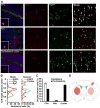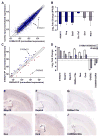Identification of the cortical neurons that mediate antidepressant responses
- PMID: 22632977
- PMCID: PMC3397430
- DOI: 10.1016/j.cell.2012.03.038
Identification of the cortical neurons that mediate antidepressant responses
Abstract
Our understanding of current treatments for depression, and the development of more specific therapies, is limited by the complexity of the circuits controlling mood and the distributed actions of antidepressants. Although the therapeutic efficacy of serotonin-specific reuptake inhibitors (SSRIs) is correlated with increases in cortical activity, the cell types crucial for their action remain unknown. Here we employ bacTRAP translational profiling to show that layer 5 corticostriatal pyramidal cells expressing p11 (S100a10) are strongly and specifically responsive to chronic antidepressant treatment. This response requires p11 and includes the specific induction of Htr4 expression. Cortex-specific deletion of p11 abolishes behavioral responses to SSRIs, but does not lead to increased depression-like behaviors. Our data identify corticostriatal projection neurons as critical for the response to antidepressants, and suggest that the regulation of serotonergic tone in this single cell type plays a pivotal role in antidepressant therapy.
Copyright © 2012 Elsevier Inc. All rights reserved.
Figures






Similar articles
-
SSRIs target prefrontal to raphe circuits during development modulating synaptic connectivity and emotional behavior.Mol Psychiatry. 2019 May;24(5):726-745. doi: 10.1038/s41380-018-0260-9. Epub 2018 Oct 2. Mol Psychiatry. 2019. PMID: 30279456 Free PMC article.
-
Cellular and molecular basis for stress-induced depression.Mol Psychiatry. 2017 Oct;22(10):1440-1447. doi: 10.1038/mp.2016.118. Epub 2016 Jul 26. Mol Psychiatry. 2017. PMID: 27457815 Free PMC article.
-
Mapping the physiological and molecular markers of stress and SSRI antidepressant treatment in S100a10 corticostriatal neurons.Mol Psychiatry. 2020 May;25(5):1112-1129. doi: 10.1038/s41380-019-0473-6. Epub 2019 Aug 20. Mol Psychiatry. 2020. PMID: 31431686 Free PMC article.
-
p11 and its role in depression and therapeutic responses to antidepressants.Nat Rev Neurosci. 2013 Oct;14(10):673-80. doi: 10.1038/nrn3564. Nat Rev Neurosci. 2013. PMID: 24002251 Free PMC article. Review.
-
Comparison of the effects of antidepressants and their metabolites on reuptake of biogenic amines and on receptor binding.Cell Mol Neurobiol. 1999 Aug;19(4):467-89. doi: 10.1023/a:1006986824213. Cell Mol Neurobiol. 1999. PMID: 10379421 Free PMC article. Review.
Cited by
-
SMARCA3, a chromatin-remodeling factor, is required for p11-dependent antidepressant action.Cell. 2013 Feb 14;152(4):831-43. doi: 10.1016/j.cell.2013.01.014. Cell. 2013. PMID: 23415230 Free PMC article.
-
Development of translating ribosome affinity purification for zebrafish.Genesis. 2013 Mar;51(3):187-92. doi: 10.1002/dvg.22363. Epub 2013 Feb 26. Genesis. 2013. PMID: 23281262 Free PMC article.
-
Cell- and region-specific expression of depression-related protein p11 (S100a10) in the brain.J Comp Neurol. 2017 Mar 1;525(4):955-975. doi: 10.1002/cne.24113. Epub 2016 Oct 21. J Comp Neurol. 2017. PMID: 27616678 Free PMC article.
-
Informing disease modelling with brain-relevant functional genomic annotations.Brain. 2019 Dec 1;142(12):3694-3712. doi: 10.1093/brain/awz295. Brain. 2019. PMID: 31603214 Free PMC article. Review.
-
Unique molecular features and cellular responses differentiate two populations of motor cortical layer 5b neurons in a preclinical model of ALS.Cell Rep. 2022 Mar 22;38(12):110556. doi: 10.1016/j.celrep.2022.110556. Cell Rep. 2022. PMID: 35320722 Free PMC article.
References
-
- Arlotta P, Molyneaux BJ, Chen J, Inoue J, Kominami R, Macklis JD. Neuronal subtype-specific genes that control corticospinal motor neuron development in vivo. Neuron. 2005;45:207–221. - PubMed
-
- Covington HE, 3rd, Lobo MK, Maze I, Vialou V, Hyman JM, Zaman S, LaPlant Q, Mouzon E, Ghose S, Tamminga CA, et al. Antidepressant effect of optogenetic stimulation of the medial prefrontal cortex. The Journal of neuroscience: the official journal of the Society for Neuroscience. 2010;30:16082–16090. - PMC - PubMed
-
- Cryan JF, Mombereau C, Vassout A. The tail suspension test as a model for assessing antidepressant activity: review of pharmacological and genetic studies in mice. Neurosci Biobehav Rev. 2005;29:571–625. - PubMed
-
- Delgado MR. Reward-related responses in the human striatum. Ann N Y Acad Sci. 2007;1104:70–88. - PubMed
Publication types
MeSH terms
Substances
Grants and funding
LinkOut - more resources
Full Text Sources
Other Literature Sources
Medical
Molecular Biology Databases
Research Materials

